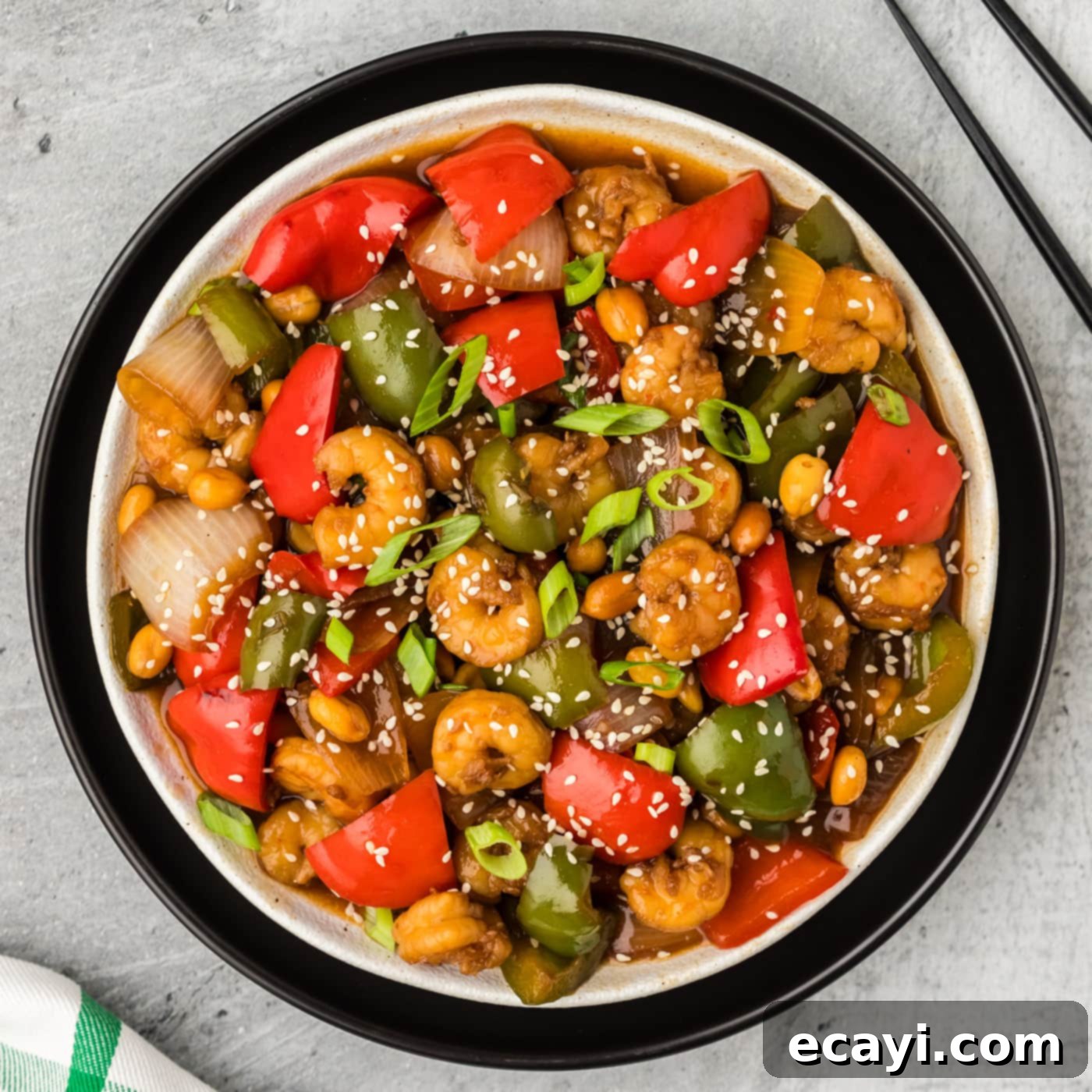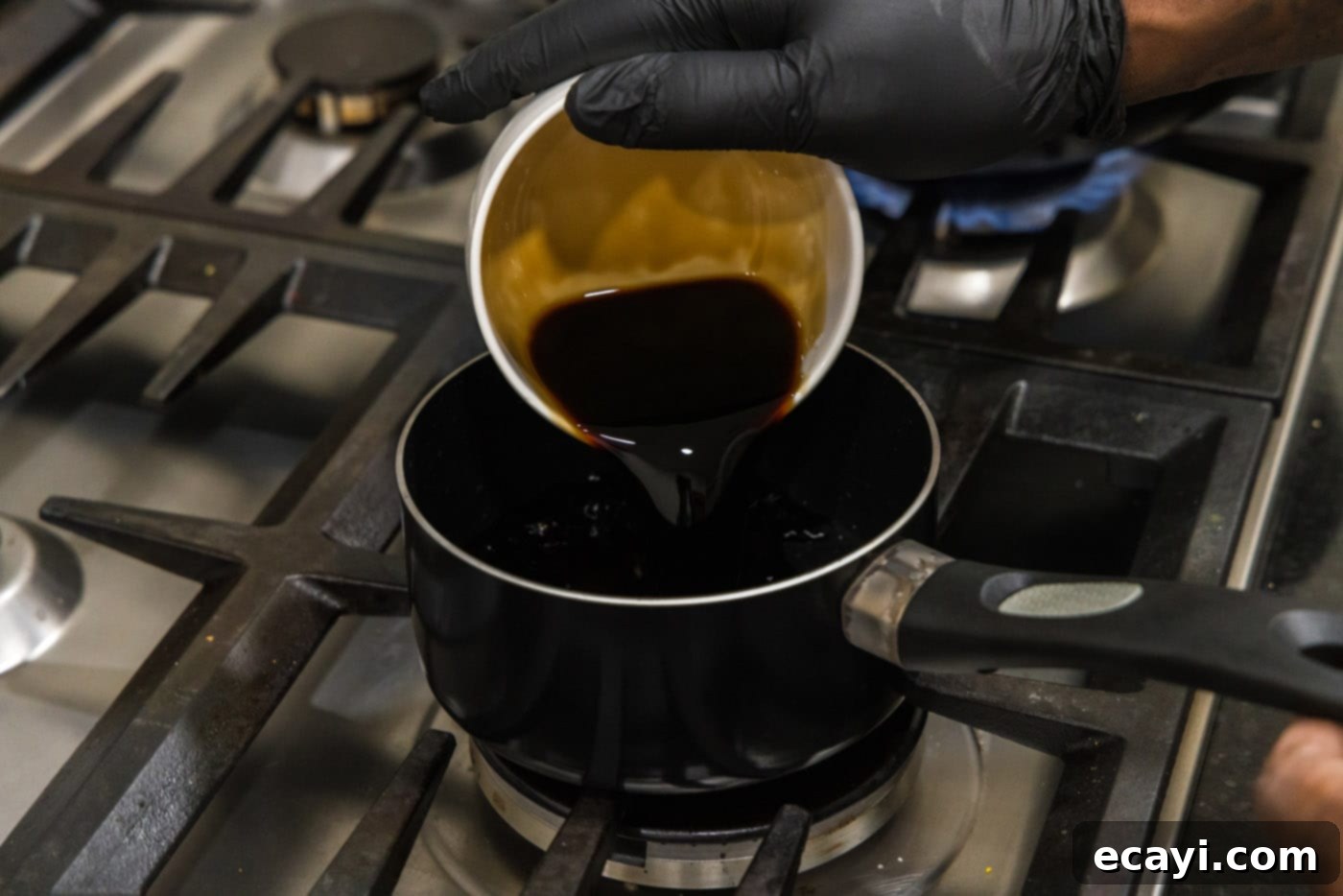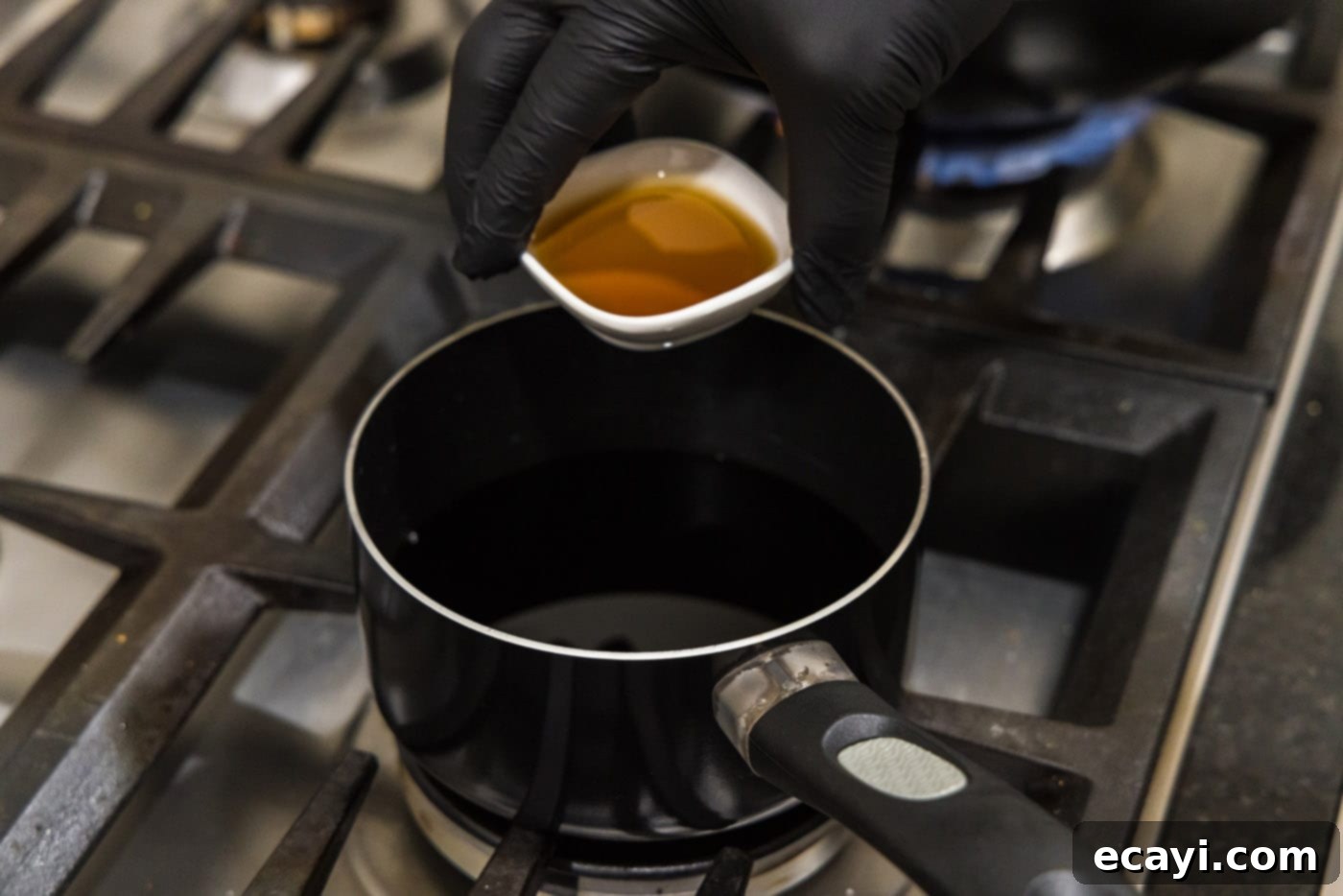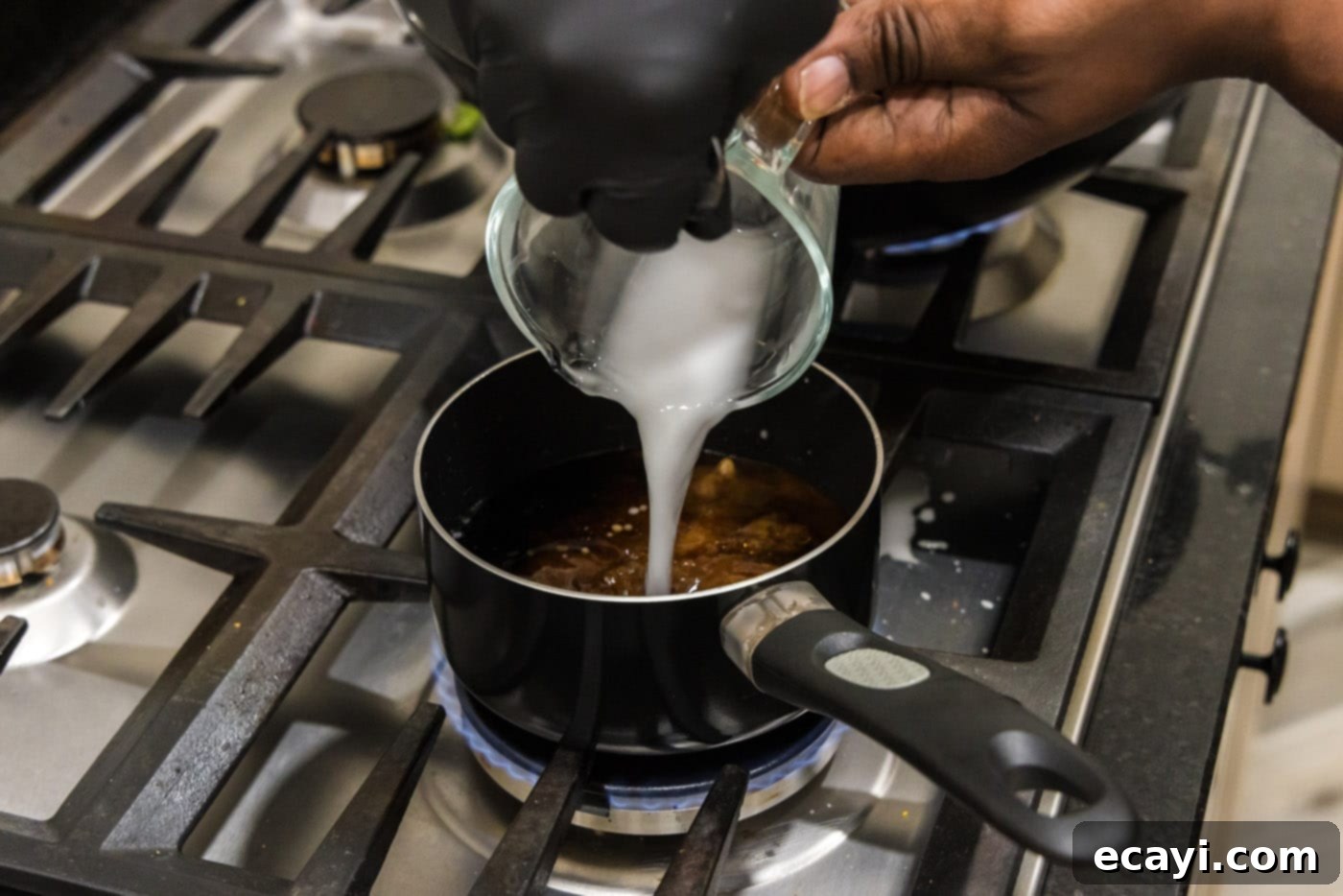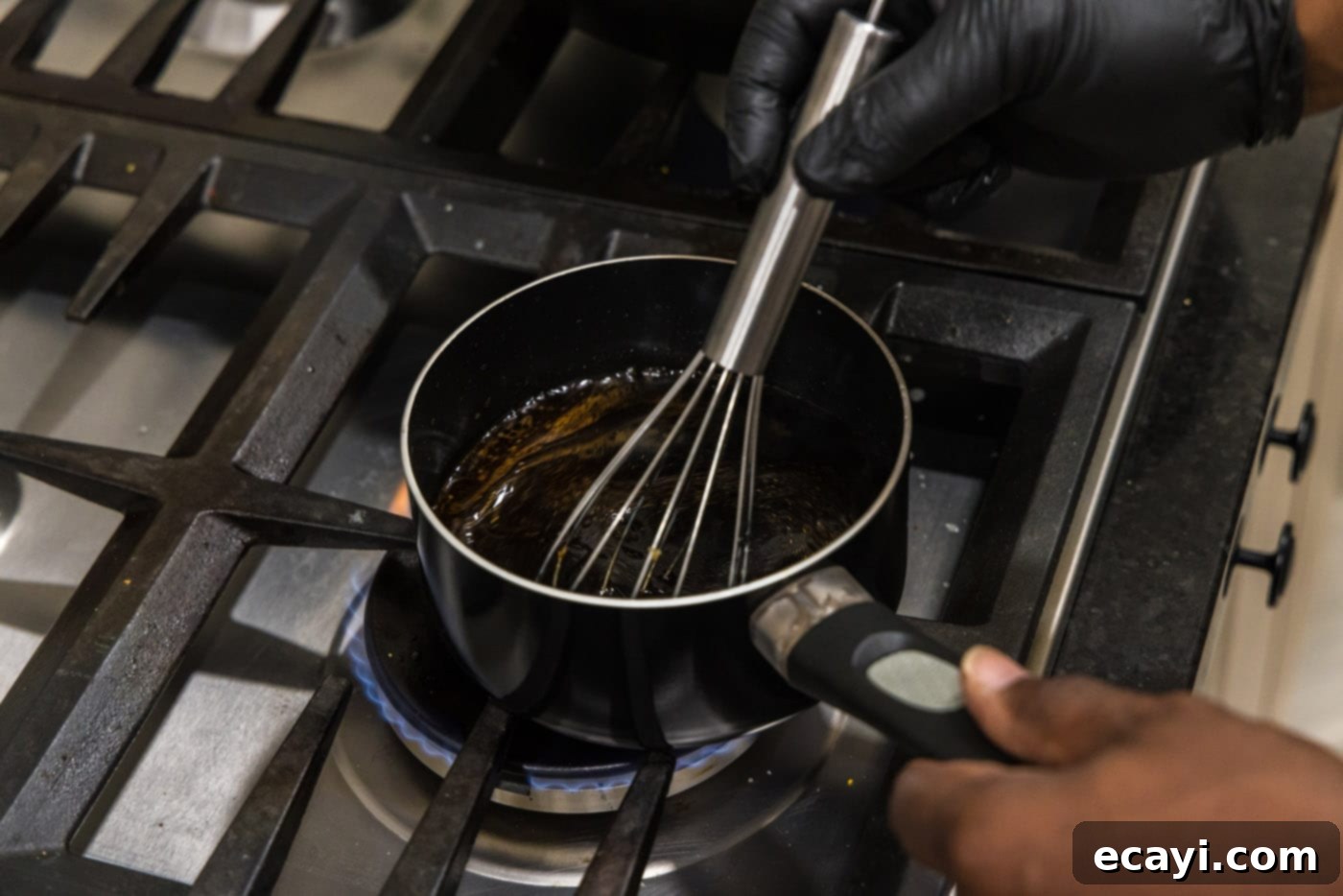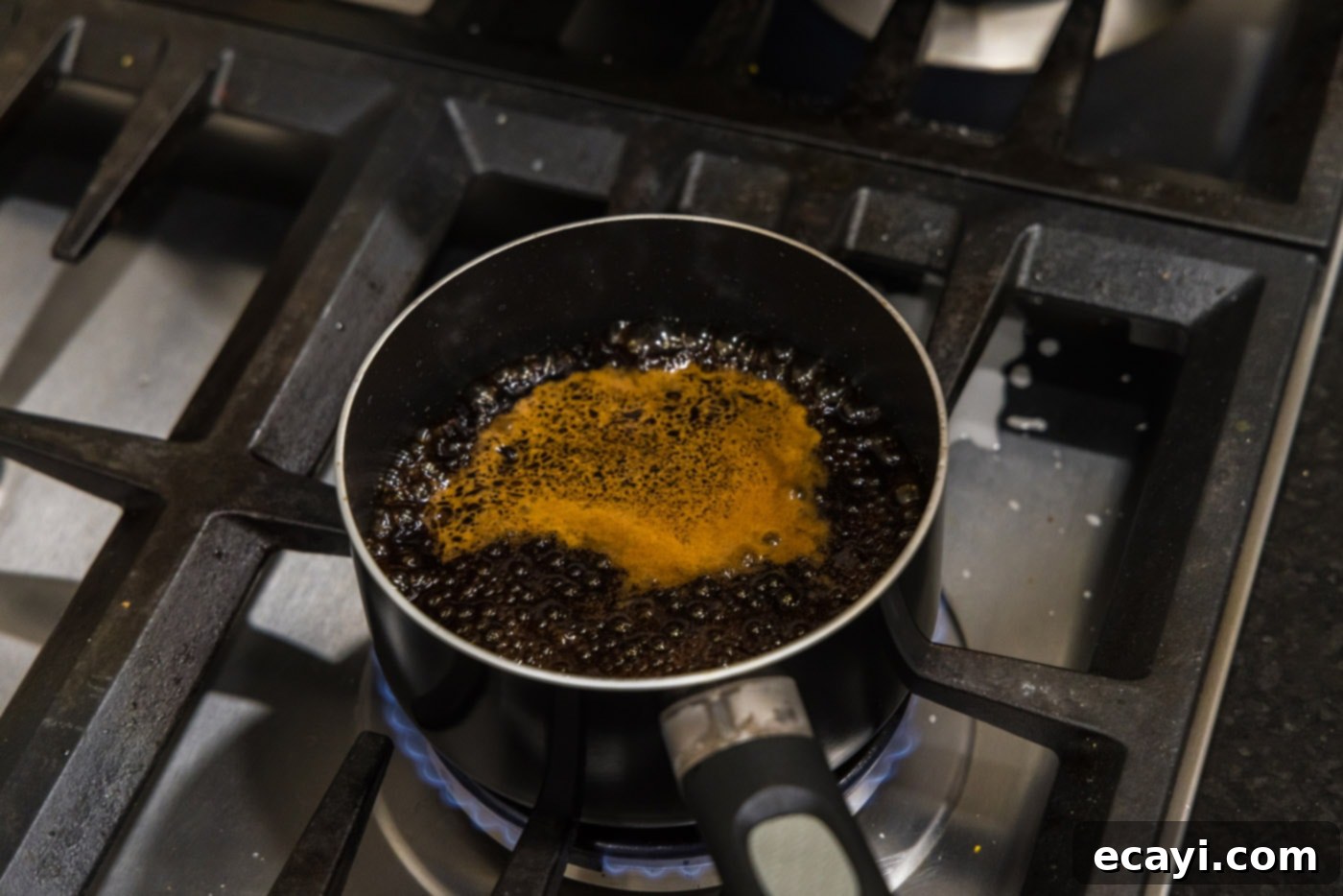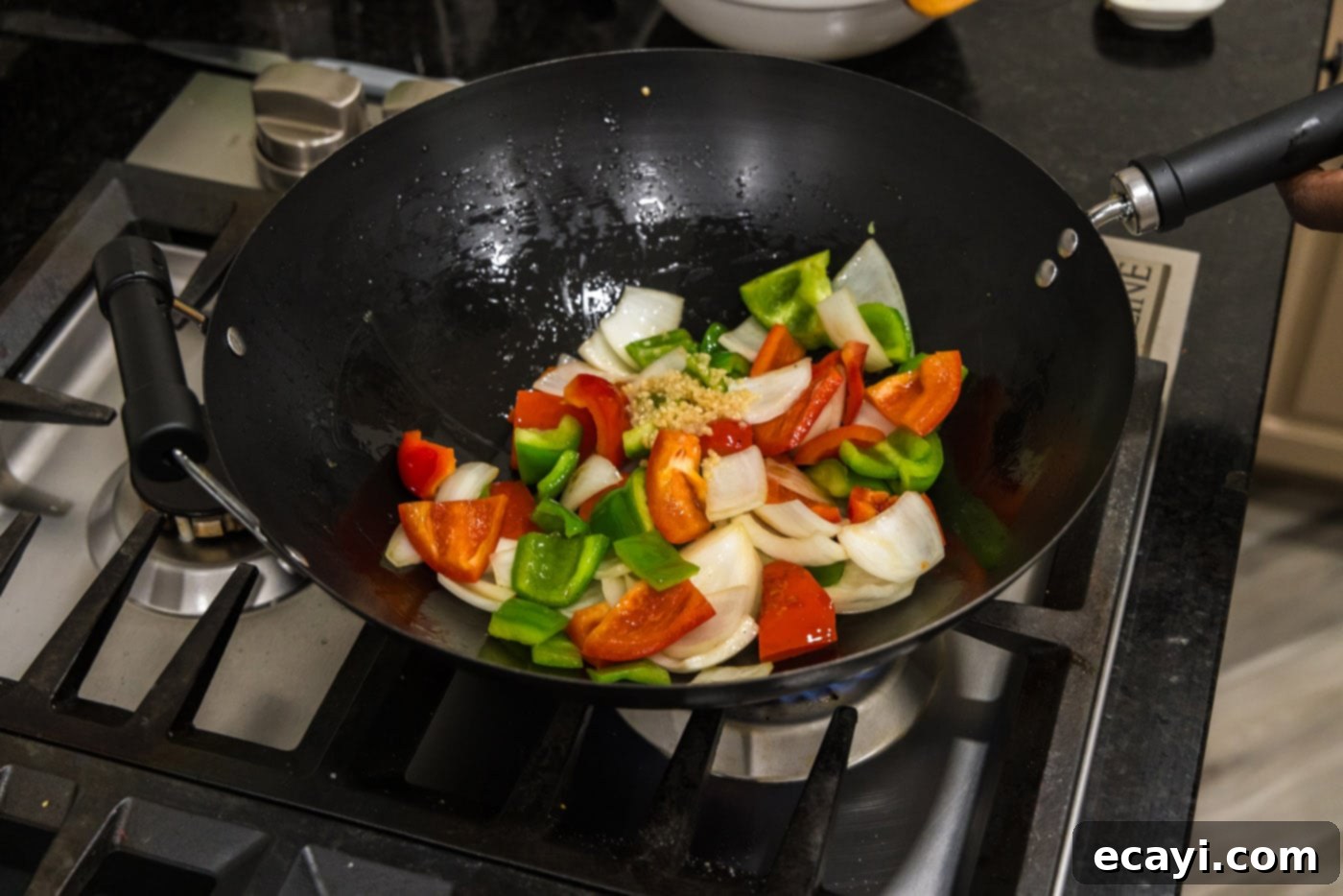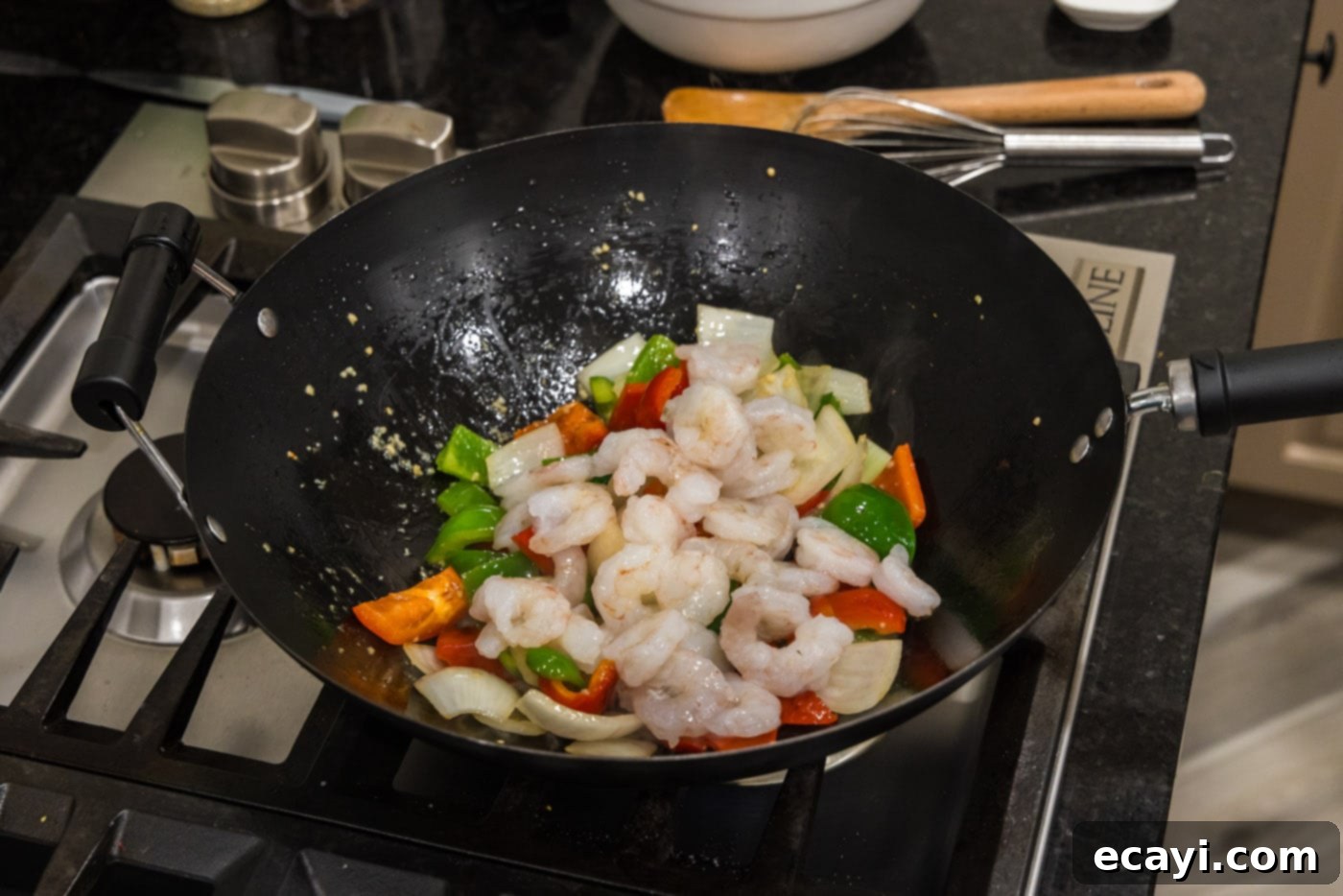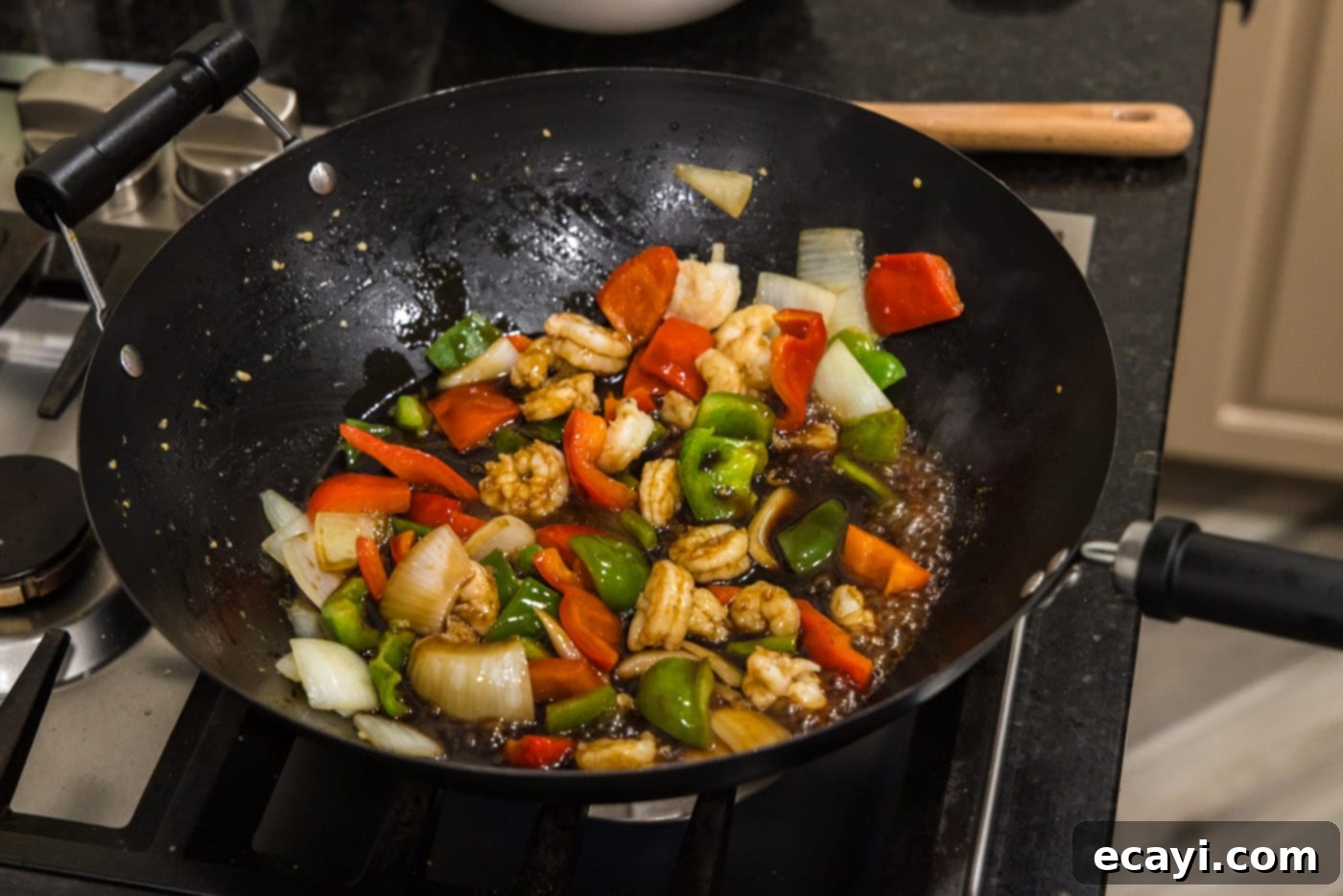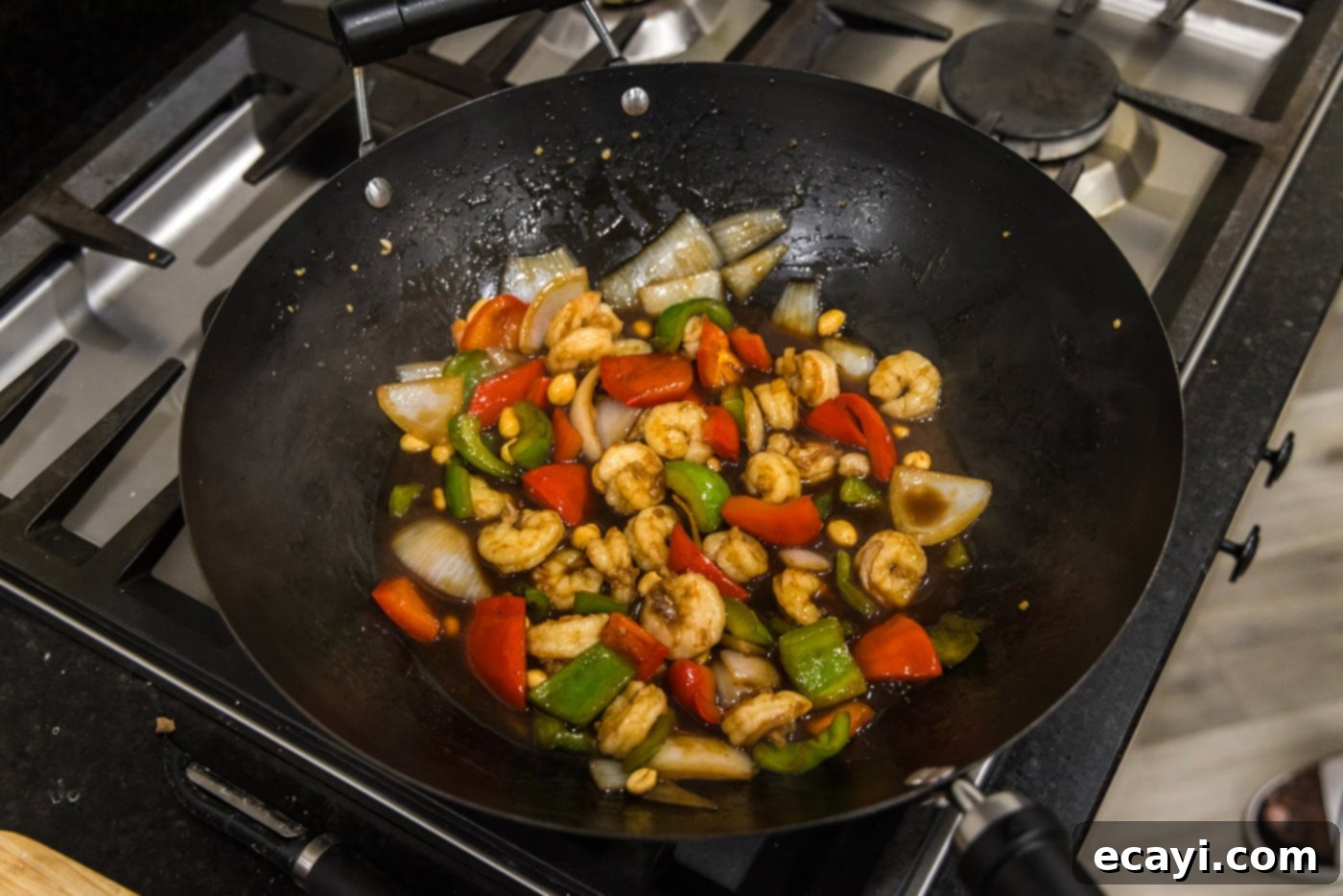Quick & Easy Kung Pao Shrimp: A Flavor-Packed Stir-Fry Ready in Under 30 Minutes!
Discover how to create an incredibly flavorful and satisfying Kung Pao Shrimp at home with this simple, speedy recipe. Featuring succulent shrimp, crunchy peanuts, and vibrant stir-fried vegetables coated in a harmonious sweet and savory sauce, this dish is your perfect answer for a quick, delicious weeknight dinner. Serve it over a bed of fluffy rice to soak up every last drop of the exquisite sauce, and prepare for a taste experience that rivals your favorite takeout!
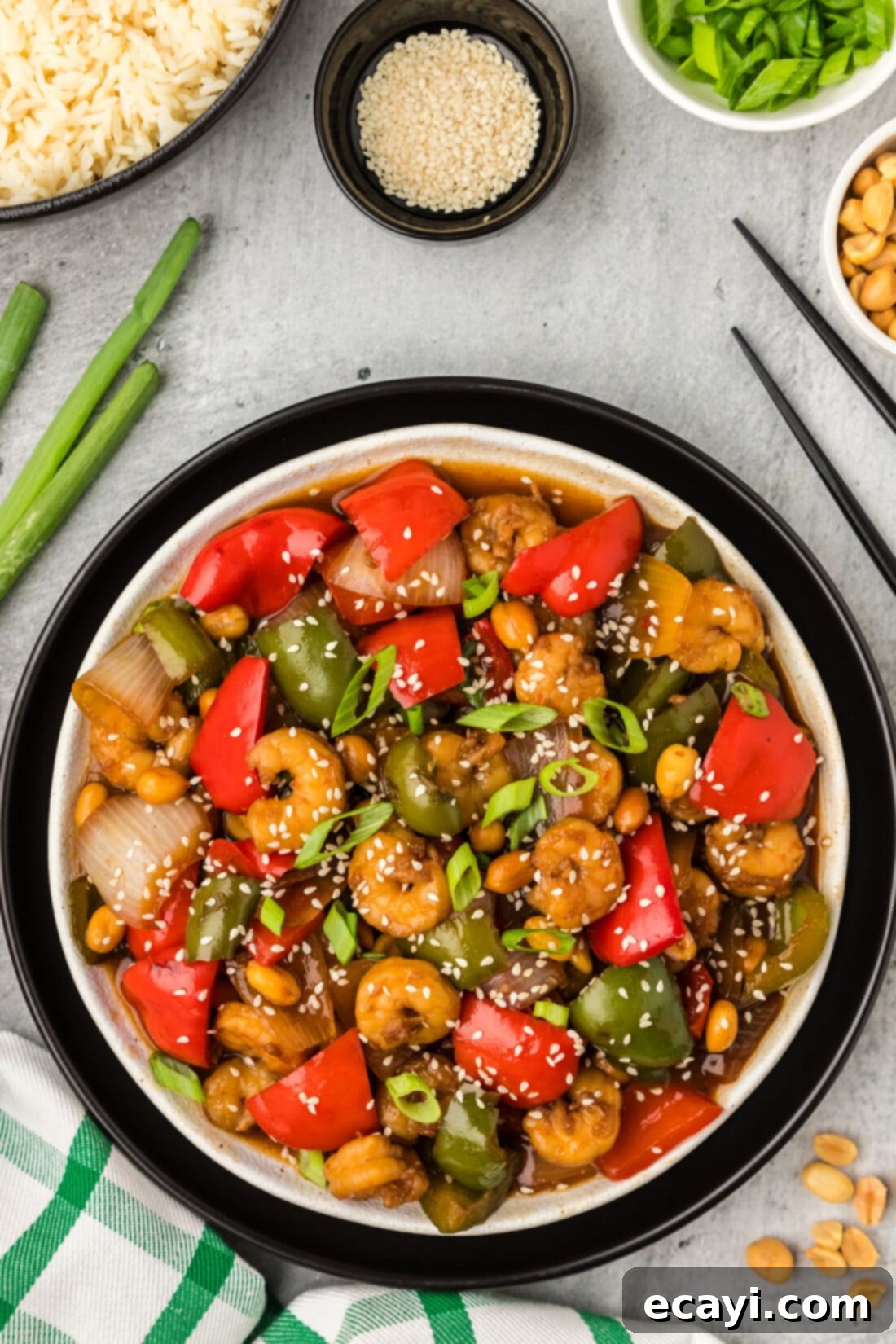
Why This Kung Pao Shrimp Recipe Will Become Your Go-To
Kung Pao Shrimp, much like its popular counterparts Kung Pao Chicken or Beef, is a Chinese-American stir-fried classic celebrated for its dynamic flavors and satisfying textures. This particular recipe stands out for several compelling reasons, making it an ideal choice for both seasoned home cooks and culinary beginners.
First and foremost, this dish is a masterclass in flavor balance. Our Kung Pao sauce is a meticulously crafted blend of sweet and savory notes, with a rich hoisin and soy base that perfectly complements the delicate taste of shrimp. It’s slightly sweet, deeply savory, and incredibly aromatic, thanks to the fresh garlic and a touch of sesame oil. While it begins with a mild profile, it’s incredibly versatile and can easily be amplified into a fiery delight with the addition of chili peppers, Sichuan peppercorns, or chili flakes, allowing you to customize the spice level to your preference. This adaptability ensures that everyone at your table, from those who prefer subtle flavors to heat enthusiasts, will find something to love.
Beyond its exceptional taste, the sheer speed and ease of preparation are what truly make this recipe a winner. We understand that weeknights can be hectic, and the last thing you need is a complicated meal. This Kung Pao Shrimp comes together in less than 30 minutes from start to finish. The stir-frying method ensures quick cooking, locking in the freshness and crunch of the bell peppers and onions, while the shrimp cooks in mere minutes. It’s an efficient way to get a wholesome, homemade meal on the table faster than ordering takeout.
Moreover, the combination of tender, juicy shrimp, crisp-tender stir-fried vegetables, and the delightful crunch of roasted peanuts provides a varied and exciting textural experience in every bite. This recipe isn’t just a meal; it’s a sensory journey that proves healthy, flavorful eating doesn’t have to be time-consuming or complex. Let’s dive into what you’ll need to create this fantastic dish.
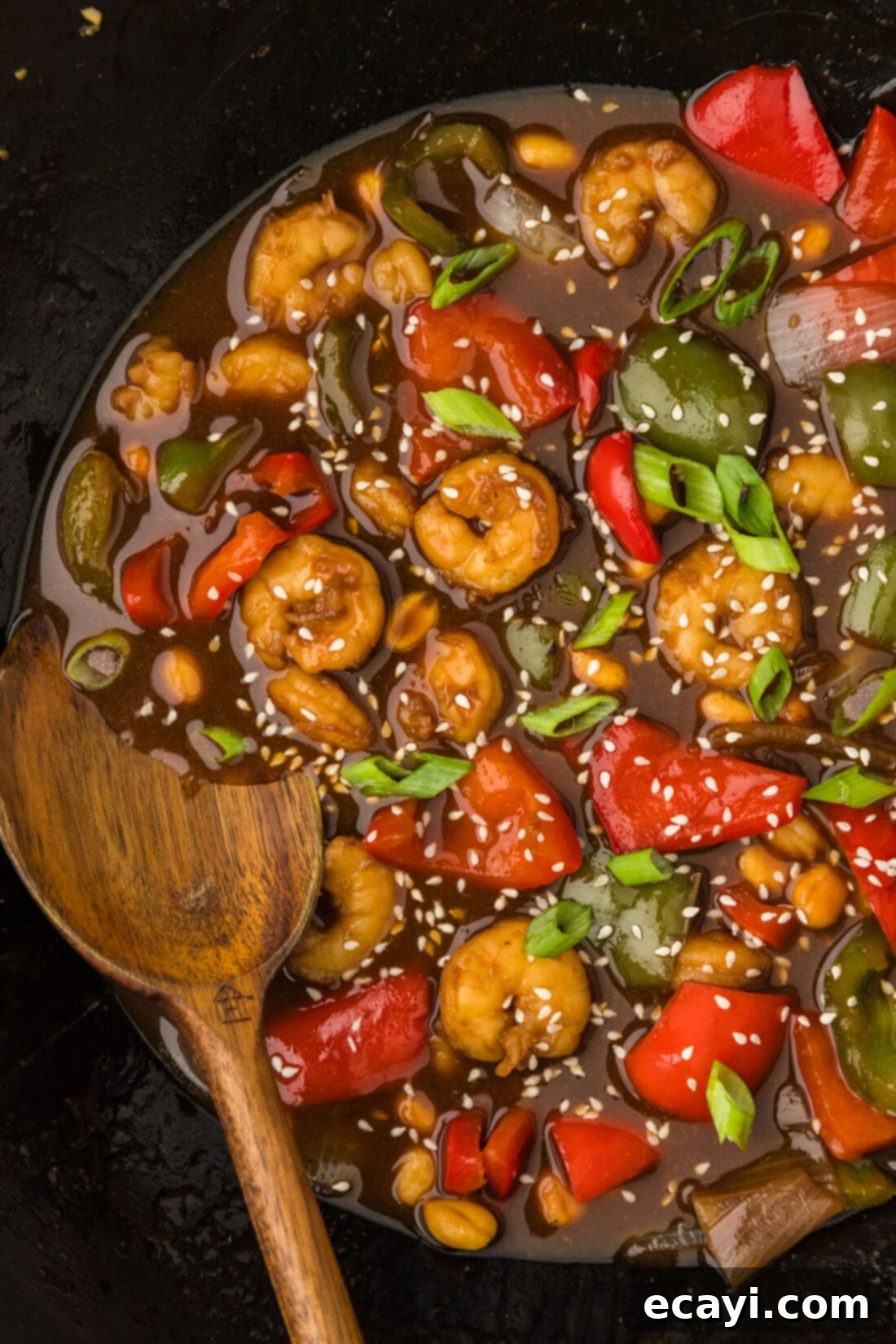
Essential Ingredients for Perfect Kung Pao Shrimp
Crafting this incredible Kung Pao Shrimp begins with selecting the right ingredients. Below is a detailed list of everything you’ll need, along with expert tips and potential substitutions to ensure your dish is nothing short of spectacular. For precise measurements and step-by-step instructions, be sure to check out the printable recipe card at the conclusion of this post.
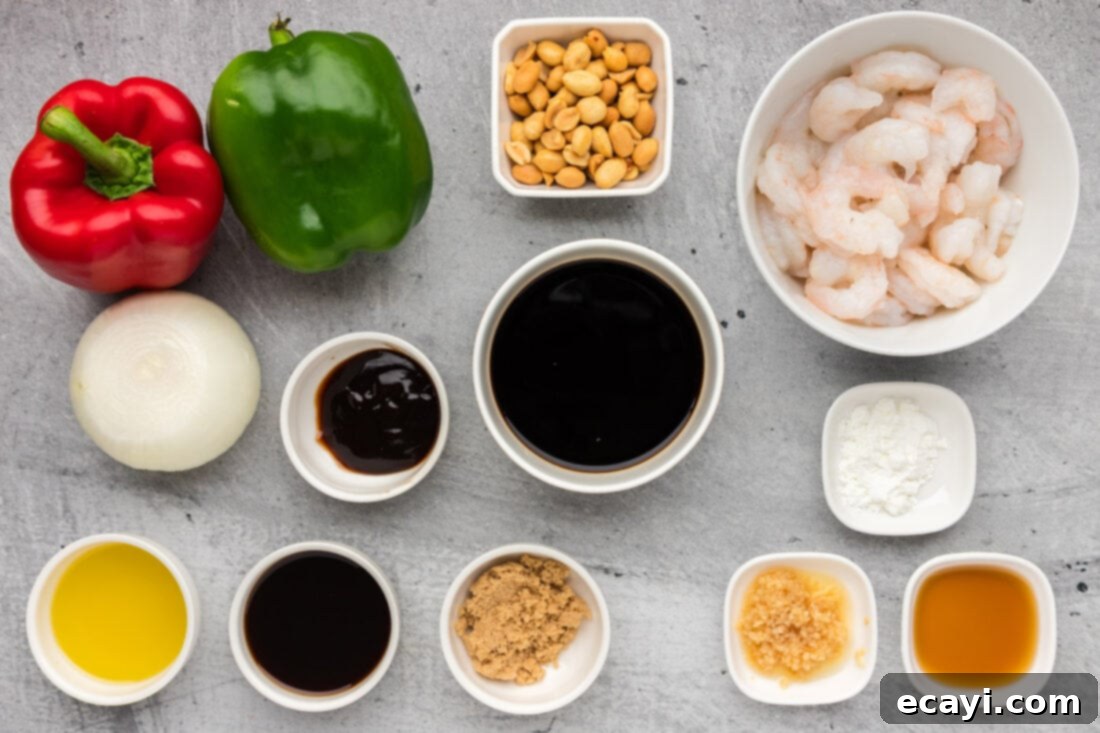
Ingredient Breakdown & Smart Substitutions
SHRIMP: The Star of the Show
For the best results, you’ll want to use raw, large shrimp that have been peeled and deveined, with their tails removed. This ensures easy eating and a beautiful presentation. If you’re using frozen shrimp, which is perfectly acceptable and often more convenient, make sure to thaw them completely before you begin cooking. Proper thawing is crucial for even cooking and to prevent the shrimp from becoming watery. Once thawed, pat them thoroughly dry with paper towels; this step is vital for achieving a good sear and preventing the shrimp from steaming in the wok. We do not recommend using pre-cooked shrimp for this recipe as they can easily become tough and rubbery when stir-fried again.
THE SIGNATURE KUNG PAO SAUCE: A Symphony of Flavors
This simple yet powerful Kung Pao sauce is the heart of the dish, delivering that irresistible balance of sweet, savory, and umami. It’s a combination of:
- Soy Sauce: The foundation of savory flavor. Use a good quality regular or low-sodium soy sauce. For a gluten-free option, tamari is an excellent substitute.
- Hoisin Sauce: This adds a distinct sweet and tangy depth, along with a beautiful reddish-brown color. It’s thick and rich, contributing significantly to the sauce’s body and complexity.
- Oyster Sauce: Essential for a deep umami flavor that elevates the entire dish. If you need a vegetarian alternative, mushroom-based “vegetarian oyster sauce” works wonderfully.
- Sesame Oil: Used sparingly as a finishing oil, toasted sesame oil provides an incredible nutty aroma. Add it towards the end or in the sauce mix to preserve its delicate flavor.
- Brown Sugar: This provides the necessary sweetness to balance the savory and tangy elements. Light or dark brown sugar will both work; dark brown sugar offers a slightly richer molasses flavor. You can adjust the amount to your taste.
- Cornstarch Slurry: A simple mixture of cornstarch and water, this is key for thickening the sauce to that perfect glossy consistency that clings beautifully to the shrimp and vegetables. Without it, the sauce would be too thin and runny.
PEANUTS: The Crunch Factor
While optional, peanuts are a classic component of Kung Pao dishes, offering a fantastic textural contrast and a rich, nutty flavor. They add a satisfying crunch that complements the tender shrimp and crisp veggies. If you have a peanut allergy or simply prefer not to use them, you can omit them entirely or substitute with other nuts like cashews for a different but equally delightful crunch.
VIBRANT VEGGIES: Color & Freshness
Our recipe calls for green and red bell peppers and onion, which contribute color, texture, and a mild sweetness. Feel free to incorporate other quick-cooking vegetables like snow peas, broccoli florets, water chestnuts, or sliced carrots to boost nutrition and variety. Ensure all vegetables are cut into similar-sized pieces for even cooking.
SPICY ADDITIONS: Turn Up the Heat!
To transform this dish into a truly spicy Kung Pao experience, don’t hesitate to add some heat. Here are a few suggestions:
- Red Jalapeños or Serranos: Fresh chilies sliced thin add a bright, immediate heat.
- Chili Flakes: A simple way to add heat that can be adjusted easily.
- Dried Chili Peppers (Sichuan style): These are traditionally used in Kung Pao for a more authentic, smoky, and aromatic heat. Add them to the hot oil at the beginning of the stir-fry until fragrant.
- Sichuan Peppercorns: For that signature “mala” (numbing and spicy) sensation characteristic of authentic Sichuan cuisine, toast a few Sichuan peppercorns in the oil before adding vegetables, then crush them and add back to the dish.
By understanding each ingredient’s role and knowing your substitution options, you’ll be well-equipped to create a customized and utterly delicious Kung Pao Shrimp that perfectly suits your palate!
Step-by-Step Guide: Crafting Your Kung Pao Shrimp
These step-by-step photos and detailed instructions are here to guide you visually through the process of making this incredibly satisfying recipe. For a convenient printable version, complete with precise measurements and instructions, you can Jump to Recipe at the bottom of this page.
- Prepare the Flavorful Kung Pao Sauce: In a small saucepan, combine the soy sauce, hoisin sauce, oyster sauce, sesame oil, and brown sugar. Whisk these ingredients together until well blended. Bring the mixture to a gentle boil over medium heat, allowing the sugar to fully dissolve and the flavors to meld. Once boiling, reduce the heat to a low simmer.


- Thicken the Sauce with a Cornstarch Slurry: In a separate small bowl, whisk together the cornstarch and water to create a smooth slurry (ensure there are no lumps). Gradually add this slurry to the simmering sauce in the saucepan, stirring continuously. Continue to simmer and stir until the sauce begins to visibly thicken and achieves a glossy consistency. This thickening process ensures the sauce will beautifully coat your shrimp and vegetables.



- Heat Your Wok for Stir-Frying: Place your wok (or a large, heavy-bottomed skillet) over medium-high heat. Add the olive oil and allow it to heat until it is shimmering. A hot wok is crucial for proper stir-frying, ensuring your vegetables are crisp-tender and not soggy. If you want to add dried chilies or Sichuan peppercorns for heat, add them now and stir-fry for 15-30 seconds until fragrant, then remove them or leave them in for more intense flavor.
- Stir-Fry the Vegetables: Add the chopped green and red bell peppers and the onion to the hot oil in the wok. Stir-fry for approximately 3-4 minutes, tossing constantly, until they are crisp-tender but still retain some bite. Next, add the minced garlic and continue to cook for another 1-2 minutes until fragrant, being careful not to burn the garlic.

- Cook the Shrimp to Perfection: Add the prepared raw shrimp to the wok with the vegetables. Stir-fry for an additional 6-7 minutes, or until the shrimp turn opaque, curl into a C-shape, and develop beautiful pink and red hues. It’s important to keep an eye on the shrimp, as they cook very quickly and can become rubbery if overcooked.


- Combine with the Sauce: Pour the thickened Kung Pao sauce directly into the wok with the cooked shrimp and vegetables. Toss everything thoroughly, ensuring all ingredients are well coated in the glossy, flavorful sauce. Continue to cook for another minute or so, allowing the sauce to heat through and evenly distribute its deliciousness.
- Add Peanuts and Serve: Finally, add the peanuts to the wok. Give everything one last gentle toss to coat the peanuts, adding that signature crunch. Remove the wok from the heat immediately to prevent overcooking. Serve your homemade Kung Pao Shrimp hot, garnished as desired, and get ready to enjoy!

Frequently Asked Questions & Expert Tips for Success
To maintain freshness and flavor, store any leftover Kung Pao Shrimp in an airtight container in the refrigerator for up to 2 days. When reheating, it’s best to do so on the stovetop over medium-low heat. Stir frequently until just rewarmed. To prevent the shrimp from becoming tough and overcooked during reheating, consider tossing them into the wok or skillet last, allowing them to warm through quickly without extended exposure to heat.
Absolutely! Frozen shrimp are a convenient and often readily available option. The key is to ensure they are completely thawed before you begin cooking. To thaw shrimp quickly and safely, place them in a sealed plastic bag and submerge the bag in a bowl of cold water for about 20-25 minutes. Avoid using hot or warm water, as this can begin to cook the shrimp and affect their texture. Once thawed, pat the shrimp thoroughly dry with paper towels to remove excess moisture; this helps them sear better and prevents the dish from becoming watery. As mentioned, we highly recommend against using pre-cooked shrimp for this recipe, as they tend to become rubbery when stir-fried again.
Shrimp cooks incredibly fast, often in just a few minutes, which also means it can be very easy to overcook. Perfectly cooked shrimp will curl into a loose “C” shape and turn opaque, displaying vibrant pink and red hues. The flesh should be firm but still tender. Overcooked shrimp, on the other hand, will typically curl tightly into an “O” shape, turn a dull whitish-grey color, and have a noticeably rubbery, tough texture. Watch them closely!
A traditional carbon steel wok is ideal for stir-frying due to its high heat retention and unique shape, which allows for quick and even cooking. However, a large, heavy-bottomed skillet or a cast-iron pan can also work effectively. Ensure your pan is large enough to accommodate all ingredients without overcrowding, as overcrowding can lower the pan temperature and lead to steamed rather than stir-fried vegetables.
Yes, absolutely! This recipe is very flexible. Feel free to add other quick-cooking vegetables like sliced mushrooms, zucchini, carrots (sliced thinly), broccoli florets, or snow peas. Add them to the wok with the bell peppers and onions, adjusting stir-frying time as needed to ensure they are crisp-tender. Cutting vegetables into similar-sized pieces will help them cook evenly.
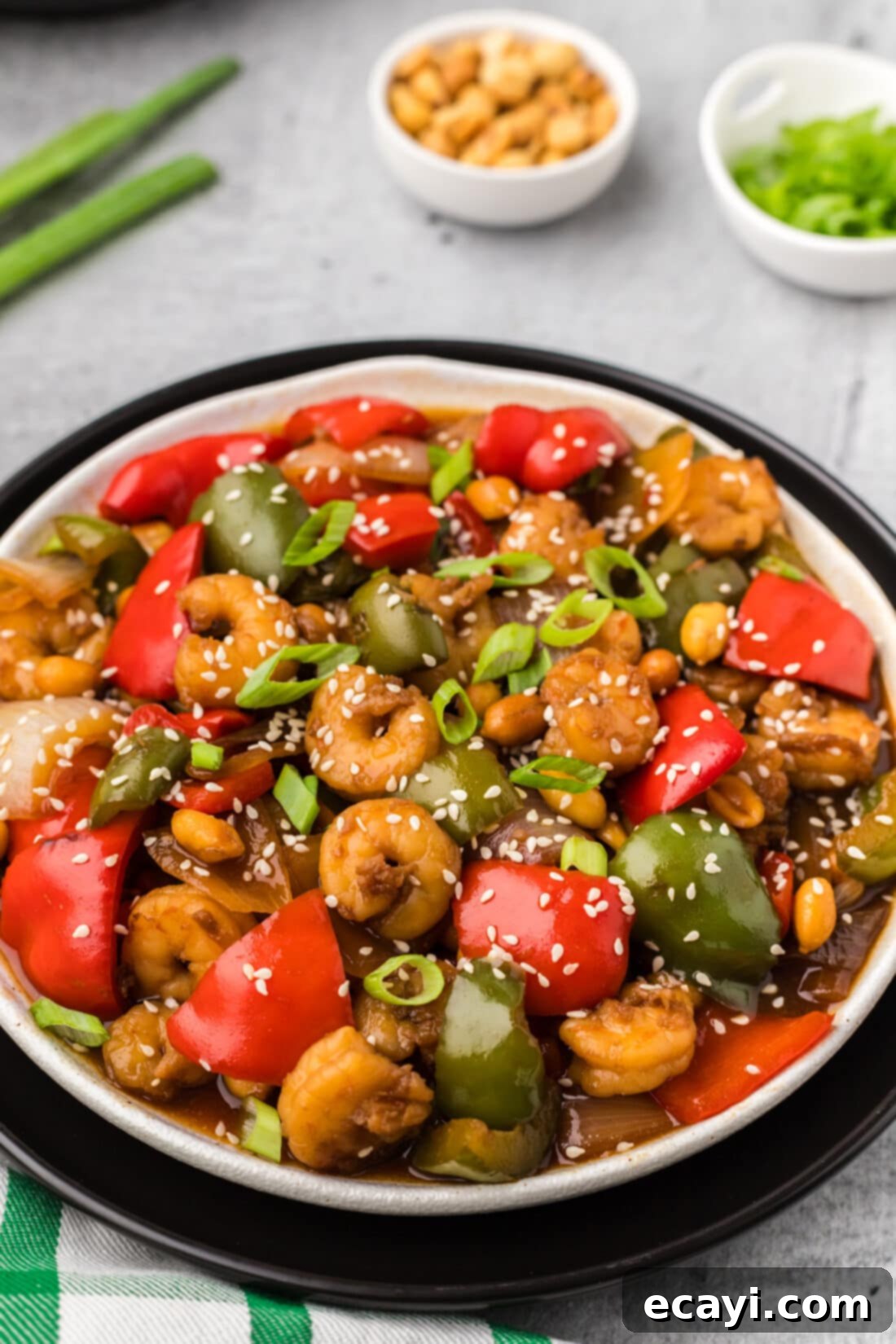
Delightful Serving Suggestions
Kung Pao Shrimp is a dish that truly shines when served alongside simple complements. The most classic pairing is, of course, a generous bed of fluffy white rice. The rice perfectly absorbs the rich, sweet, and savory sauce, ensuring you don’t miss a single drop of its deliciousness. For a healthier or varied option, consider serving it with brown rice, quinoa, or even cauliflower rice.
Beyond rice, you can elevate your meal with a few simple garnishes:
- Sliced Green Onions: A sprinkle of freshly chopped green onions adds a burst of fresh flavor and a vibrant green color.
- Toasted Sesame Seeds: These provide a subtle nutty flavor and an appealing visual finish.
- Fresh Cilantro: For those who love it, a scattering of fresh cilantro leaves can add a bright, herbaceous note.
- Lime Wedges: A squeeze of fresh lime juice just before eating can add a wonderful zing that brightens all the flavors.
For a more substantial meal, consider pairing your Kung Pao Shrimp with other Asian-inspired sides such as crispy egg rolls, light spring rolls, or a simple cucumber salad. Enjoy the explosion of flavors in every bite!
More Irresistible Shrimp Recipes to Try
If you’ve fallen in love with the ease and flavor of this Kung Pao Shrimp, you’ll be thrilled to explore more of our fantastic shrimp recipes. Seafood, especially shrimp, is a wonderful choice for quick, healthy, and flavorful meals. Here are some of our favorites:
- Hunan Shrimp: A fiery and flavorful dish perfect for spice lovers.
- Honey Walnut Shrimp: A popular, sweet, and crispy delight that’s surprisingly easy to make.
- Sweet and Sour Shrimp: A classic takeout favorite with a tangy and vibrant sauce.
- Salt and Pepper Shrimp: Simple yet incredibly addictive, focusing on crispy texture and aromatic seasoning.
- Shrimp and Broccoli: A wholesome and quick stir-fry combining lean protein with healthy greens.
I love to bake and cook and share my kitchen experience with all of you! Remembering to come back each day can be tough, that’s why I offer a convenient newsletter every time a new recipe posts. Simply subscribe and start receiving your free daily recipes!
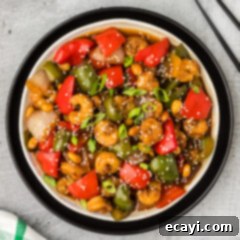
Kung Pao Shrimp
IMPORTANT – There are often Frequently Asked Questions within the blog post that you may find helpful. Simply scroll back up to read them!
Print It
Pin It
Rate It
Save ItSaved!
Ingredients
- 2 Tablespoons olive oil
- 1 medium green bell pepper chopped into chunks
- 1 medium red bell pepper chopped into chunks
- 1 medium onion chopped into chunks
- 1 Tablespoon minced garlic
- 10 ounces raw large shrimp peeled, deveined, tails removed
- ¼ cup peanuts
Sauce
- ¼ cup soy sauce
- 1 Tablespoon hoisin sauce
- 2 Tablespoons oyster sauce
- 2 teaspoons sesame oil
- 1 Tablespoon brown sugar
- 1 teaspoon cornstarch
- ½ cup water
Things You’ll Need
-
Wok
-
Saucepan
Before You Begin
- For frozen shrimp – allow them to thaw first then pat them dry before beginning. To thaw shrimp quickly, place them in a sealed plastic bag and submerge them in a bowl of cold water for around 25 minutes. Do not use hot or warm water. I would not recommend using precooked shrimp for this recipe.
- You can omit the peanuts if desired, or substitute with cashews for a different crunch.
- To make this dish spicy, feel free to add some red jalapeños, chili flakes, dried chili peppers, or Sichuan peppercorns during the stir-frying process. Adjust the quantity to your preferred level of heat.
Instructions
To Make the Sauce
-
In a small saucepan, combine soy sauce, hoisin sauce, oyster sauce, sesame oil, and brown sugar. Bring to a gentle boil, then reduce heat to a simmer.
-
Make a slurry by whisking together cornstarch and water. Add this slurry to the saucepan and continue to simmer, stirring occasionally, until the sauce begins to thicken to a desirable consistency. Remove from heat and set aside.
To Make the Vegetables and Shrimp
-
Heat olive oil in a wok or large skillet over medium-high heat until it shimmers. If adding dried chilies or Sichuan peppercorns for spice, add them now and stir-fry briefly until fragrant.
-
Add the chopped green and red bell peppers and the onion to the hot oil. Stir-fry for 3-4 minutes until they are crisp-tender. Then, add the minced garlic and cook for another 1-2 minutes until fragrant.
-
Add the raw shrimp to the wok and stir-fry for an additional 6-7 minutes, or until the shrimp are opaque, cooked through, and turn pink. Be careful not to overcook them.
-
Pour the previously thickened Kung Pao sauce into the wok. Toss everything thoroughly to coat the shrimp and vegetables evenly, allowing the sauce to heat through for about 1 minute.
-
Finally, add the peanuts to the wok and toss to combine. Remove from heat immediately and serve your delicious Kung Pao Shrimp hot over rice.
Expert Tips & FAQs
- Shrimp cooks very quickly, typically turning opaque with pink/red hues and curling into a ‘C’ shape when done. Overcooked shrimp will be tough, rubbery, and a whitish-grey color. Watch them closely to avoid overcooking.
- Store any leftovers in an airtight container in the refrigerator for up to 2 days. When reheating on the stovetop over medium-low heat, consider adding the shrimp last to avoid overcooking them again.
- For optimal stir-frying, ensure your wok or skillet is very hot before adding ingredients. This helps achieve that desirable crisp-tender texture for vegetables and a good sear on the shrimp.
- Prep all your ingredients (chop vegetables, thaw shrimp, mix sauce) before you start cooking. Stir-frying is a fast process, and having everything ready will make it much smoother.
Nutrition
The recipes on this blog are tested with a conventional gas oven and gas stovetop. It’s important to note that some ovens, especially as they age, can cook and bake inconsistently. Using an inexpensive oven thermometer can assure you that your oven is truly heating to the proper temperature. If you use a toaster oven or countertop oven, please keep in mind that they may not distribute heat the same as a conventional full sized oven and you may need to adjust your cooking/baking times. In the case of recipes made with a pressure cooker, air fryer, slow cooker, or other appliance, a link to the appliances we use is listed within each respective recipe. For baking recipes where measurements are given by weight, please note that results may not be the same if cups are used instead, and we can’t guarantee success with that method.
